Choosing The Best Hardscape Materials For Your Backyard
Most homeowners dream of having a beautiful outdoor area where they can invite the neighbors over, grill a few steaks, and have meaningful conversations in a space they love.
Unfortunately, well-designed landscapes, patios, and decks are something many of us never experience.
We do our best to create functional and aesthetically pleasing spaces, but most often, the result doesn't look like the dream we had in our minds.
At Ebyland, we understand this frustration. Our years of experience in the landscaping industry have taught us that stunning outdoor spaces don't just happen overnight.
That's why we've written this article on the best materials to create a gorgeous hardscape design. Now, you can confidently create the hardscape of your dreams.
Let's get started!
What Is A Hardscape?
Let's begin by ensuring we know what a "hardscape" is.
Hardscaping vs. Landscaping
Hardscaping is a subcategory of landscaping.
According to dictionary.com, landscaping is "Improving the appearance of (an area of land, a highway, etc.), as by planting trees, shrubs, or grass, or altering the contours of the ground."
Hardscaping is "The manmade part of the grounds surrounding a building…"
In other words:
Hardscapes are the nonliving elements of a landscape—like a brick patio, concrete path, or stone statue. They make up one facet of your overall landscaping.

Alternatively, softscapes are the living elements of a landscape design—flowers, grass, trees, and bushes. Softscaping is important too—and though we don’t discuss it in this article, you can learn more about it in our “Guide To Planting Trees and Shrubs.”
But today, we want to tell you all about the nonliving elements of your landscape!
Why Hardscaping Is Important
Hardscaping is an essential part of creating the ideal outdoor space. Let’s look at a few of the reasons why this is true.
- Hardscapes are functional. Softscapes are a beautiful, essential part of every good landscape. But you probably don’t want your grill in the middle of a flower bed or your prize roses to serve as a walkway. Hardscapes allow you to create spaces that actually make your life easier, like a cement pad for a table or a stone walkway.
- Hardscapes are beautiful. Thankfully, hardscapes aren't only for practical purposes. They can look amazing too. If you need some examples, check out the stunning work in this hardscape catalog.
- Hardscapes are low maintenance. Once you create the design of your dreams, your backyard is set for years to come. That means no watering, mowing, or pruning is needed.
- Hardscapes increase the value of your property. When you create an outdoor extension to your home, you add more usable space to your property. Potential buyers can envision relaxing and enjoying that space. In fact, 87% of buyers look for an outdoor patio when purchasing a home.

Just like most good things in life, hardscaping requires an up-front investment of your time and money. But normally, the investment is well worth it!
The investment is so profitable that John Duffy of Duffy Real Estate says the new mantra for homeowners and homebuyers is “location, location, landscape.”
What Kind of Landscaping Do You Need?
Now we know that hardscapes are a valuable investment in your property. But what if your property would benefit more from softscaping than hardscaping?
How do you know which type of landscaping your property would benefit from the most?
In reality, hardscaping and softscaping are meant to be used in conjunction with each other, and you shouldn't focus on one to the exclusion of the other.
If you want to know how to incorporate both types of "scaping" into a beautiful backyard, check out our blog on backyard design.
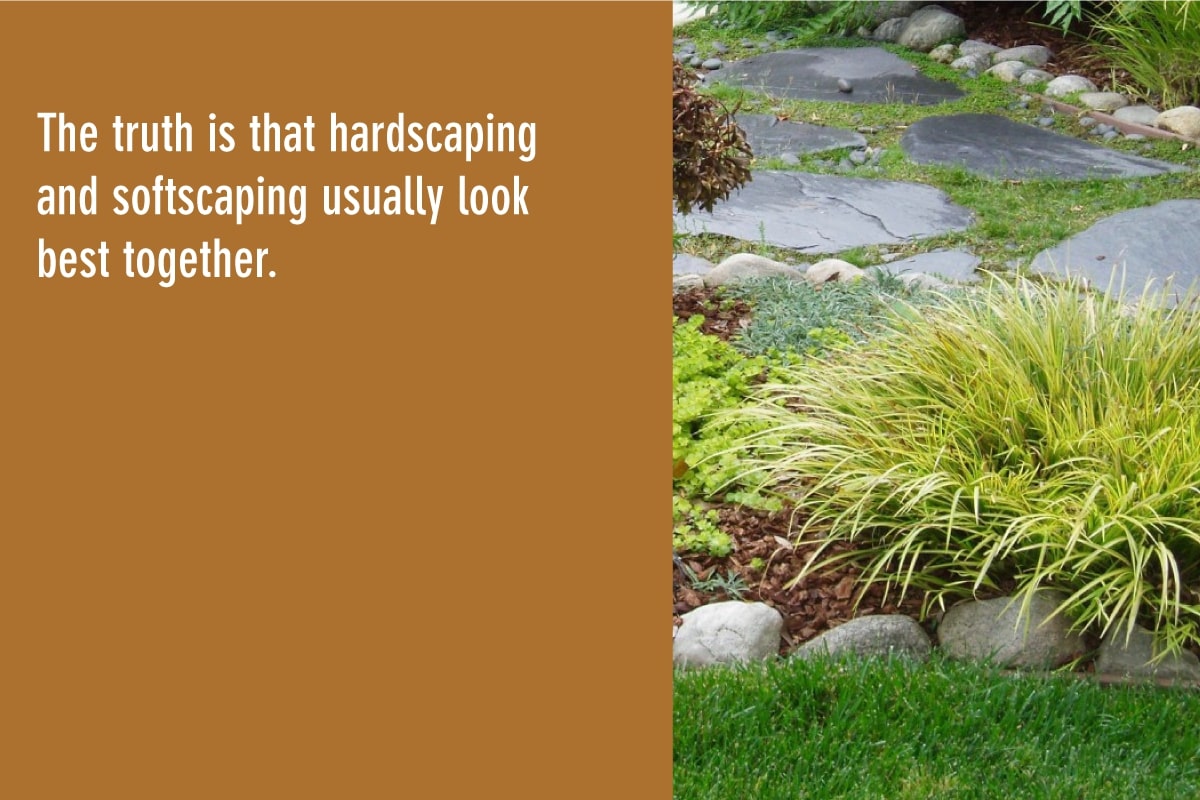
However, here are a few questions to ask yourself to determine which type of "scaping" is best for your property:
Question #1: Is your property flat, or does it have hilly contours?
You can significantly enhance a generally flat property with creative hardscaping. Hardscapes allow you to add levels and dimensions to your yard, making it a much more interesting and inviting space.
On the other hand, a property that includes slopes or rolling contours is prime space for some creative softscaping. The trees, bushes, and flowers enhance a naturally hilly landscape and make it exquisite.
Question #2: What's more prevalent in your area—greenery or concrete?
Look around you. What do you see? Houses, sidewalks, industrial buildings, yards, woods, and streams?
For those living in urban areas, the texture and green of softscaping bring a relaxing and natural atmosphere to the backyard. If you live in a rural area, hardscaping breaks up the monotony of big lawns and adds a manicured look to your property.
Question #3: How much hosting do you do?
If you love having family and friends over for an evening outside, you need a well-designed hardscape to be your hosting spot. You can set up outdoor furniture, fire up the grill, and enjoy friendship.
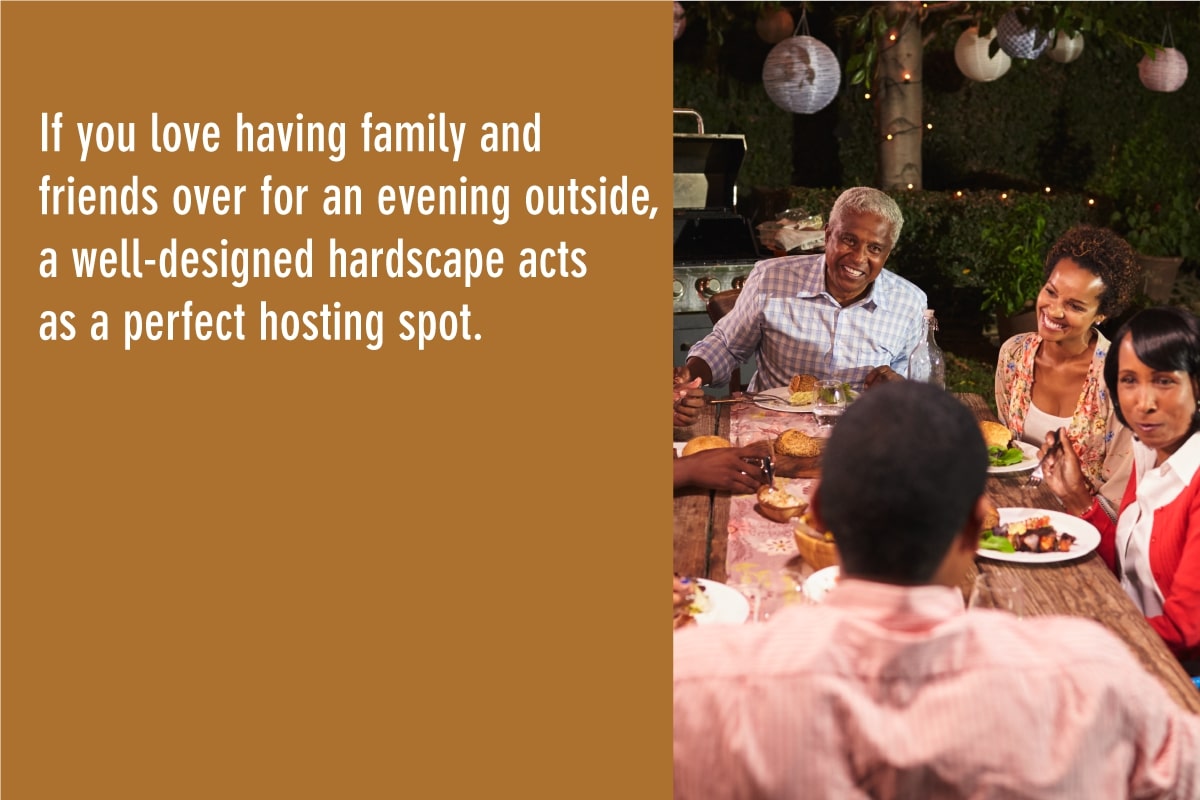
On the other hand, nothing invites privacy and relaxation like a good softscape. If you need a backyard oasis away from the hustle and bustle, a few well-positioned trees and shrubs get the job done better than most types of hardscaping. They can also act as a privacy barrier between you and your neighbors without the seeming hostility a fence can create.
Question #4: Do you have a groundskeeper?
Landscaping that includes a lot of softscaping is beautiful, but it's much more work to maintain! If you don't have time for mulching, trimming, weeding, fertilizing, and more, your best bet may be to incorporate more hardscapes since they often require zero maintenance.
Question #5: What is your preferred style?
Hardscapes, like driveways and walks, generally give a sense of structure to a plot of land. They are geometric, easily organized, and less natural and wild. In short, they look more manicured than softscapes.
Softscapes can be planned but still have a mind of their own. Although you can trim a bush, you can't tell how fast it grows or where to put out branches! This leads to a free, natural look, so if you want your yard to look wild and free, go heavy on the softscapes!

BONUS TIP: Mulching is a great way to spruce up any softscape. Read our blog on everything you need to know about mulch in 2020 for some great tips on mulching like a pro!
As we’ve already mentioned, hardscapes and softscapes should be used together, but answering the questions listed here will help you determine which type is more of a priority to you.
Types of Materials Used in Hardscapes
We could say a lot about different landscape styles, but in this article, we are focusing on hardscapes.
So, let’s explore some of the most common types of materials used in hardscapes.
If you want to know more about what to use in your overall landscaping, check out our blog on landscape materials for a beautiful backyard.
Using Pavers in Hardscapes
Pavers are one of the most quintessential hardscape materials out there.
In essence, landscape pavers are paving stones made from tile, brick, or concrete.
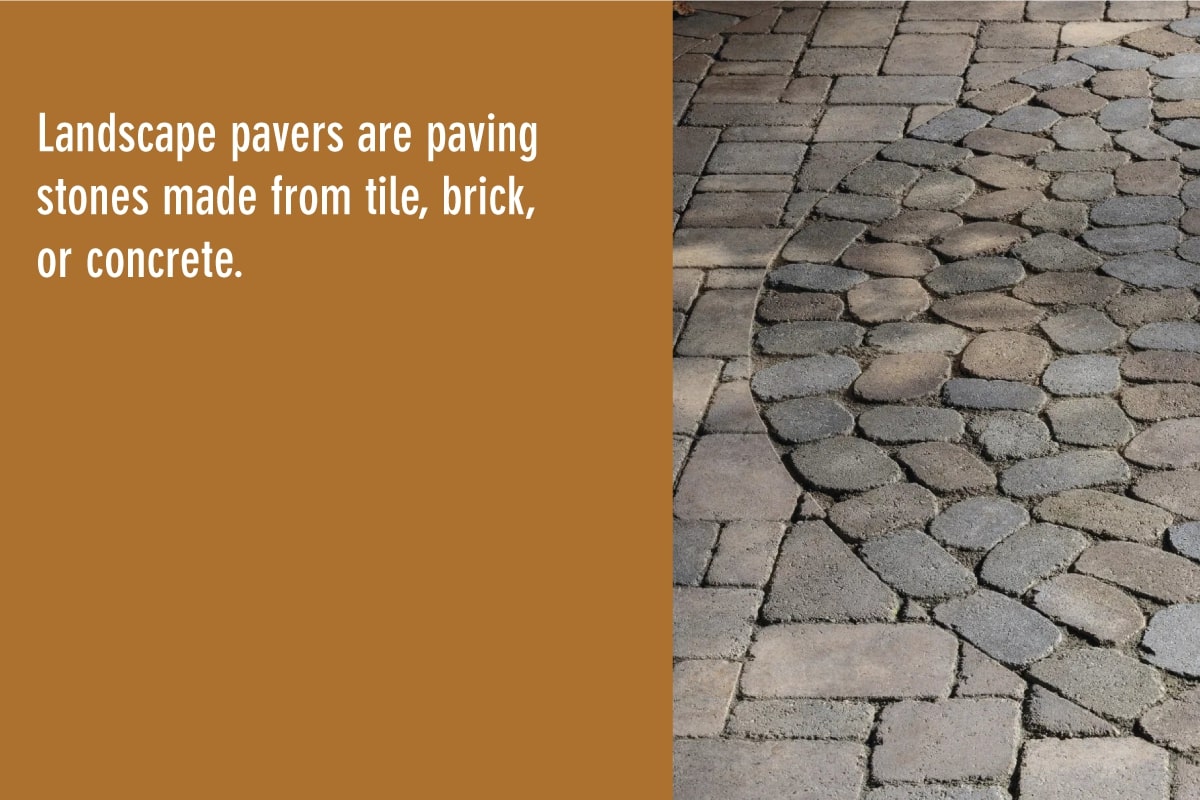
Since it's easy to manipulate concrete's shape, size, and color, pavers come in different aesthetics.
Want to change the color? Just adjust the coloring agent.
Want to change the shape? Simply tweak the shape of the mold.
But using landscaping pavers isn't the best option in every scenario. Let's take a look at the pros and cons of pavers and the best times to use them.
Pros of Landscaping Pavers
1- Pavers are durable and long-lasting. Have you noticed the cracks that run through most slabs of concrete? That is because the concrete is all in one large piece with no give. Since pavers are small and interlocking, they have more flex and rarely break or crack.
In fact, most pavers are three to four times stronger than the concrete foundations of homes!
Beyond that, the color goes the whole way through the stone. That means that when a small chip gets broken off of a paver, it's barely noticeable.
2- Pavers handle seasonal changes like a pro. During the winter months, moisture in the ground freezes and thaws. When this happens, the soil expands and contracts.
Large solid objects on the ground, like concrete slabs, face incredible stress and are likely to crack. However, smaller pavers should be fine, although you should keep them stable by laying down a great base.
Since pavers are fit together individually, each piece can move without cracking the surface. You may have to adjust slightly, but at least your patio won't be cracked!

3- Pavers are low maintenance. If one of your pavers does end up getting damaged, it's a piece of cake to take care of it. Simply remove the old paver, buy a new one, and replace it.
You can see how much less work this is than breaking out an entire compromised concrete slab.
Pavers are also easy to maintain. You can sweep them off with a broom, and most stains can be cleaned up with a bucket of soap and water.
Cons of Landscaping Pavers
1- Pavers aren’t easy to install. Since every single paver needs to be put in place individually, making a paver patio can take days.
On top of that, the process itself is no breeze. Pavers aren’t the best DIY project, but if you want an idea of the work it takes to install pavers, read this article from Home Depot.
2- Pavers can be more expensive than other options. You’ll likely have a greater upfront cost for a paver patio than a poured cement patio, due to the higher manufacturing and labor costs that come with pavers.
The pavers themselves can be a bit pricey, depending on what type you want, and the preparation work also costs money. Using pavers also requires you to purchase base materials such as gravel and sand. And since they take more time to install, your labor costs will be higher.
3- Pavers can grow weeds over time. Hardscapes created using pavers have lots of joints and cracks. This makes the hardscape very durable, but it also allows weeds to grow between the cracks over time, decreasing the appeal of your hardscape and creating work for you.
Thankfully, solving this issue is pretty simple. Polymeric sand can be applied as a finishing touch to pavers. When installed correctly, it hardens in the paver joints and doesn’t allow weeds to take root.
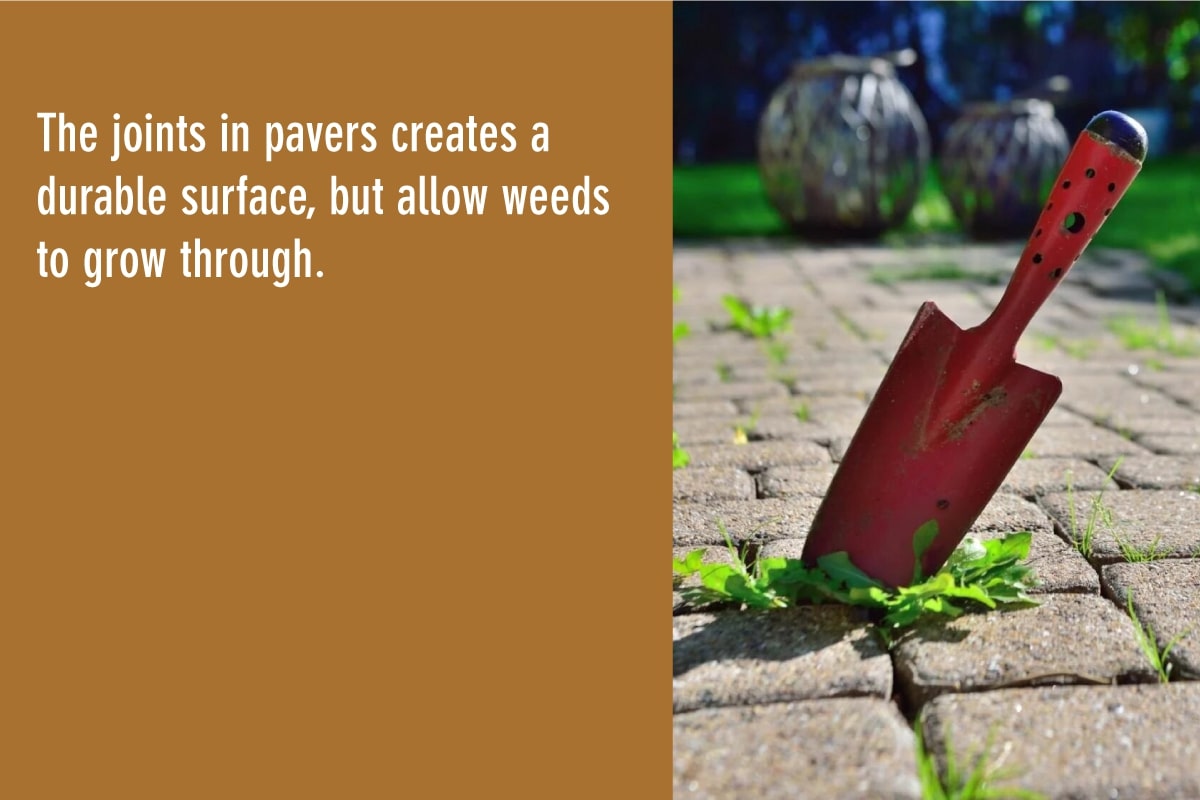
When To Use Landscaping Pavers
Now we know some of the pros and cons of landscaping pavers. But when should you use pavers, and when should you opt for something else?
If beauty and quality are your top priorities, pavers are a great option. They are beautiful and classy—often reminiscent of an old-world European feel. Besides that, they are authentic--you can mimic the look of pavers with poured concrete, but nothing beats the real thing!
Paving stones are also an excellent long-term investment. They add curb appeal to your home, raise your home value, and last a very long time. So, if you are playing the long game, pavers may be your best option.
But if you have a limited budget or want a product you can install easily, pavers shouldn’t be your top pick. Gravel and concrete are significantly cheaper than pavers, while brick has a similar price to landscaping pavers.
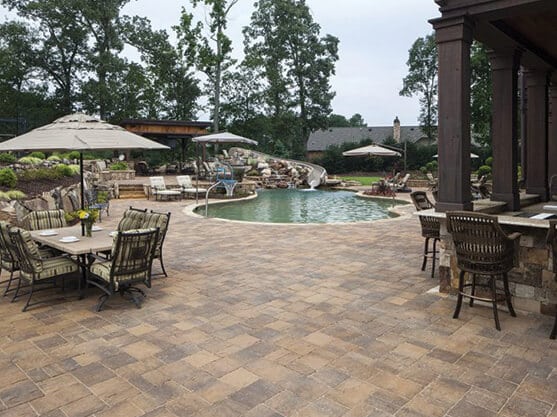
Using Concrete in Hardscapes
If you aren't thrilled with landscaping pavers' price or installation complications, consider using concrete in your hardscape design. Concrete is simpler and cheaper than pavers.
Concrete is one of Earth's most versatile and widely used construction materials. And all it takes is a bit of research, and you can pour your own concrete! Just ensure you know what you are doing before attempting this, though. You don't want to end up with a patio that looks like an undulating ocean!
But before we get ahead of ourselves, let's explore the pros and cons of using concrete in a landscape design.
Pros of Concrete
1- Concrete is versatile. Concrete is so versatile that you'll never have to worry about your concrete hardscape looking just like your neighbor's.
Why?
You can make it any shape you can dream up! This allows you to accommodate backyard space restrictions or incorporate attractive curves.
Using stains and other coloring methods, you can also achieve just about any hue imaginable, whether you want to match the stone facade of your house or blend in with the natural landscape. And if your dye goes the whole way through your concrete, you won't have to worry about cracks and chips.

2- Concrete installs faster and easier than pavers. If you don't like the idea of having your backyard out of commission for several days or weeks, you might opt for concrete.
Concrete can be installed more efficiently than pavers or natural stone because it is poured as a slab. Pouring concrete also takes less site preparation than installing pavers. It will take some time to harden, but it's still faster than laying every paver.
Beware, though—you shouldn't walk on freshly poured concrete for 1-3 days to allow it to set and cure properly. Also, concrete is a slab instead of separate pieces, so it may crack more easily.
3- Concrete is an affordable option. What keeps people from making home improvements? One of the main issues is money.
Thankfully, installing a concrete hardscape doesn't break the bank. In general concrete costs around $7-$10 per square foot, while paving stones cost around $13-16 per square foot.

Cons of Concrete
1- Concrete can split and crack. While concrete is in good condition, it is easy to maintain. However, when the ground starts to freeze and thaw, concrete can begin to crack.
The real bummer about this is that concrete is not easy to fix if it cracks. When a portion of concrete begins to crack, a much larger concrete section has to be replaced. It is especially hard to replace concrete if it is dyed a specific color because the color may be hard to replicate.
2- Wet concrete can be slippery. If you are using concrete in an area with lots of foot traffic, beware.
Concrete slabs can become slippery when wet, especially if they have been treated with a protective sealant. This problem is exacerbated because concrete often doesn't have much texture, giving your shoes less material to grip.
(Concrete pavers can have this same issue, though most of them are textured, and the cracks between the pavers can help too. You can also texture concrete, which helps it not to be so slippery.)
3- Concrete has less resale value. In some ways, this is to be expected. Concrete costs less money to install, but also returns less on the investment.
In general, concrete’s resale value is less than paving stones because potential buyers see concrete as less beautiful than pavers. Beyond that, concrete probably won’t last as long and will cost more money when repairs are needed.
When to Use Concrete
There are definite upsides and downsides to using concrete in a hardscape. So how can you know when the time is right to choose concrete?
If you are doing an extensive hardscape project like a long driveway, concrete may be a great option. Remember, the larger the project, the greater the cost difference between concrete and paving stones.
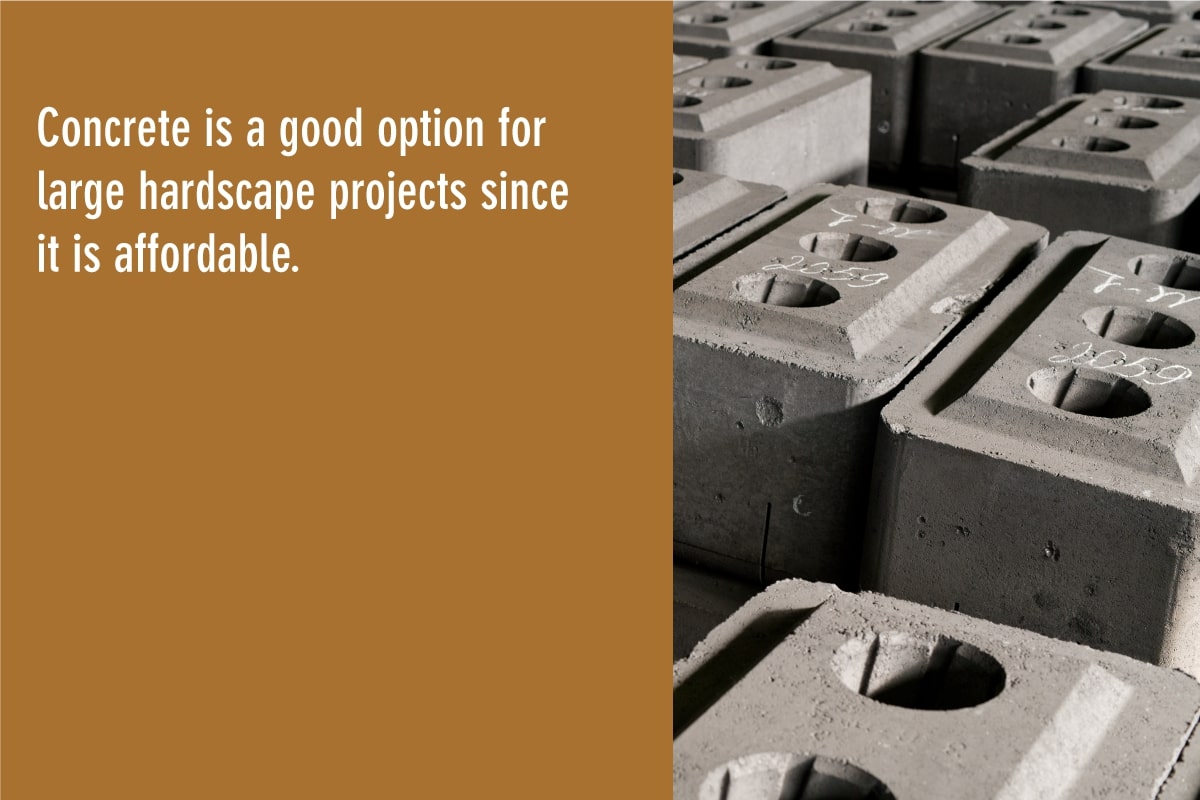
Another time to consider concrete is when function trumps beauty. If you want a pleasant, clean area for a fire ring, concrete is a great option. If having the “wow” factor is essential, it’s probably best to consider something else.
And if you are working with a limited budget, concrete is the best option for you. You truly can create an attractive hardscape using poured concrete, all while keeping your savings account above water.
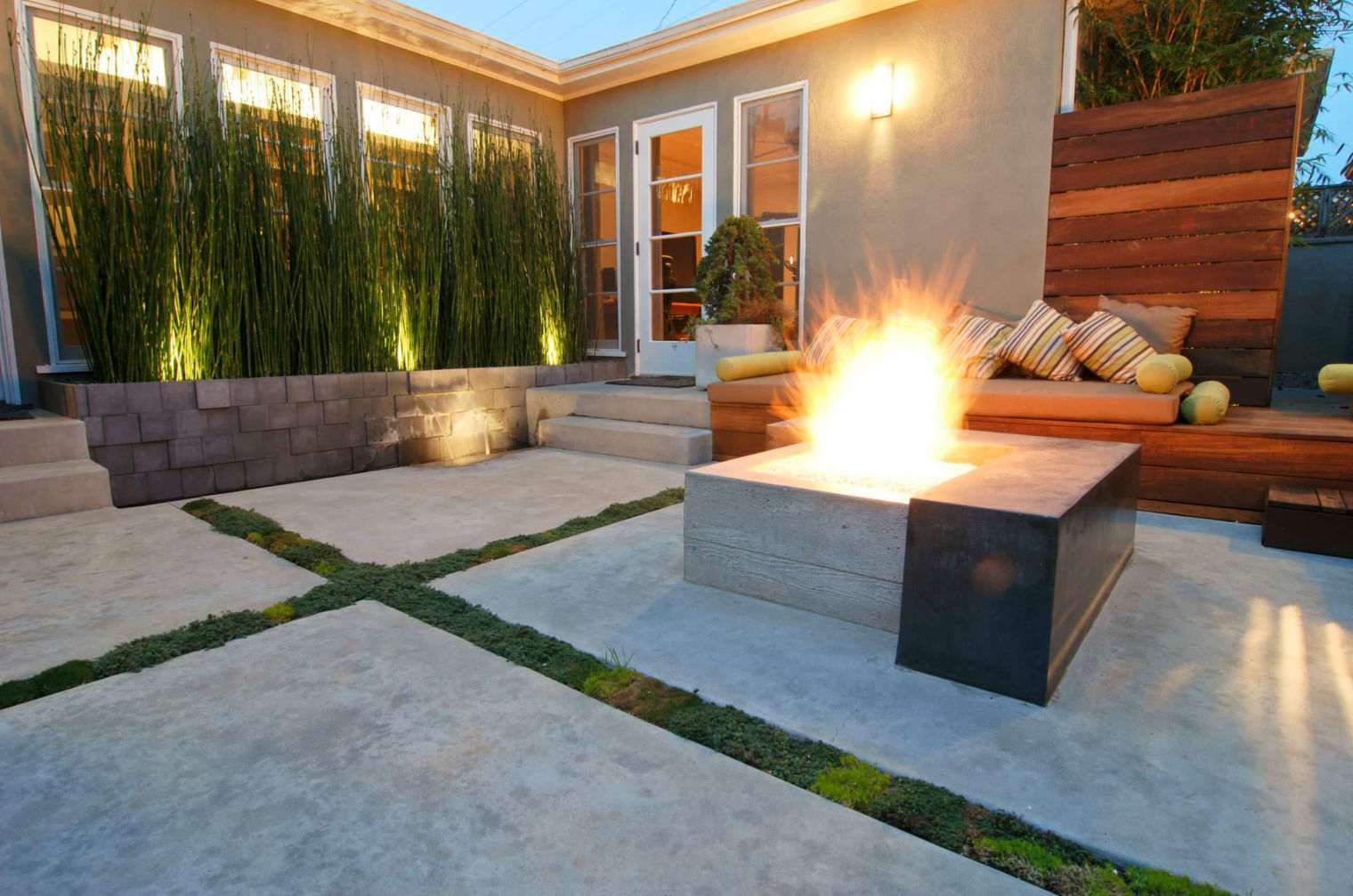
Using Stamped Concrete in Hardscapes
On one end of the hardscape continuum, you have pavers, which are beautiful but expensive.
On the other side, you have regular, poured concrete. It is affordable and practical but not as aesthetically attractive.
And in the middle, you have stamped concrete. Stamped concrete is an upgrade over poured concrete when it comes to beauty and is also less expensive than pavers. It's the middle ground between the two.
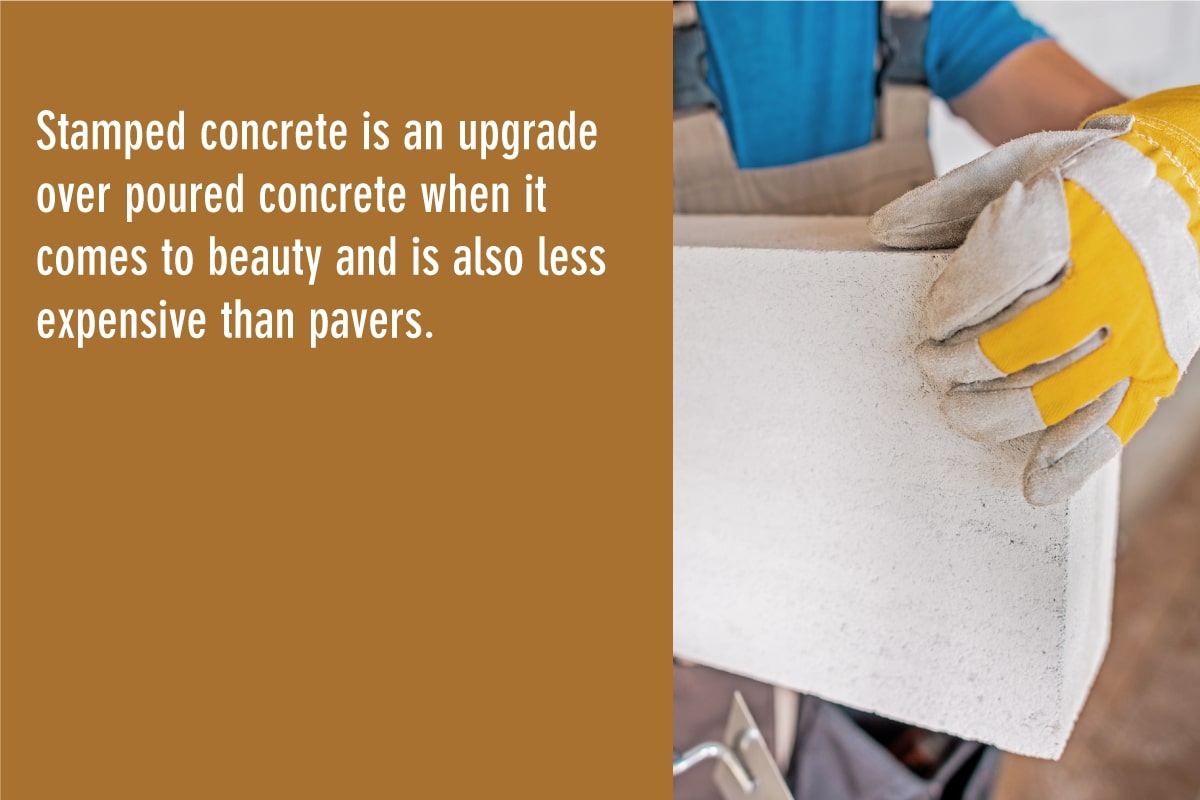
Stamped concrete is concrete that's been stamped with texture and design. Stamped concrete can look like wood, stone, tile, slate, and other items. And it can look pretty close to the real thing, too!
Let's go ahead and take a look at some of the pros and cons of stamped concrete.
Pros of Stamped Concrete
In many ways, the pros and cons of stamped concrete resemble regular concrete since it is made from the same base material and behaves in the same general way. To create this list of pros and cons, we will focus particularly on the "stamped" part of the concrete.
1- Stamped concrete is aesthetically pleasing. Stamped concrete is a definite aesthetic upgrade over regular concrete, primarily because it can be made to look like natural stone, tile, etc.
And stamped concrete looks very realistic because most stamping mats are molded from the actual materials they are designed to replicate. It can be pretty hard to tell the difference between the original and the replica!
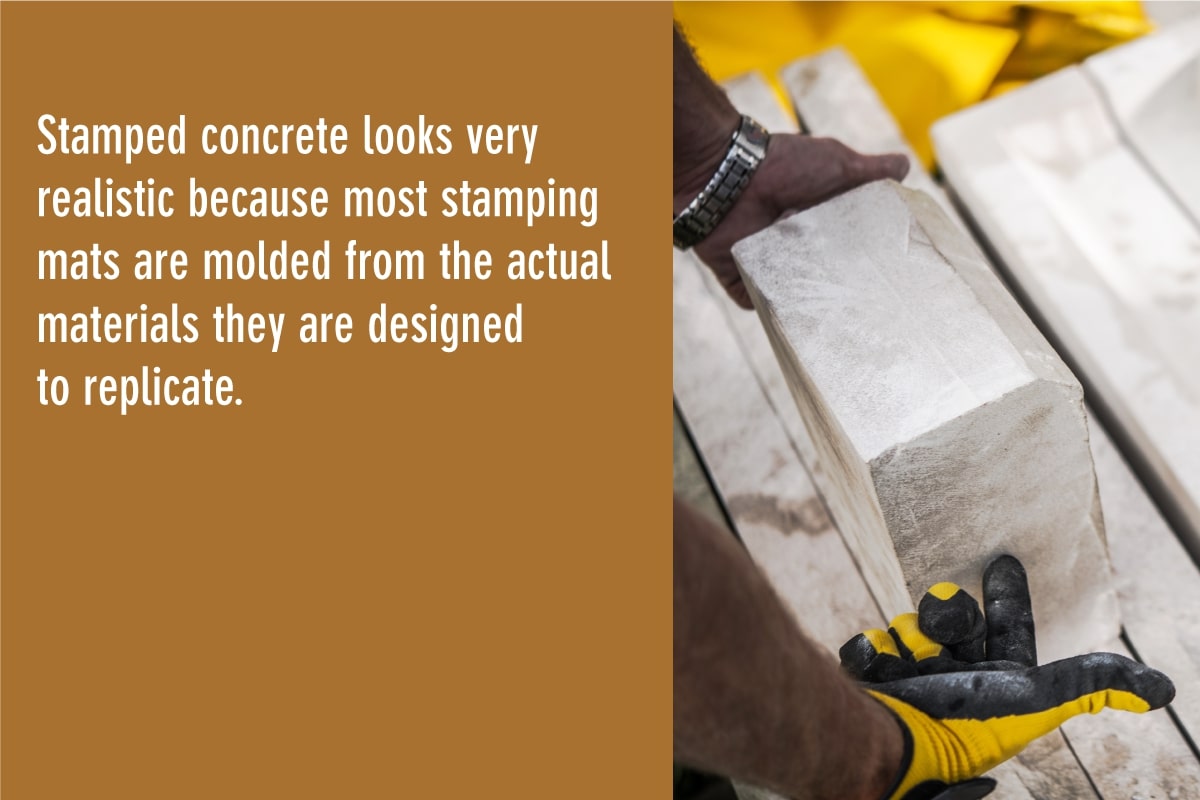
2- Stamped concrete is incredibly versatile. Sure, pavers come in various colors, shapes, and textures, and poured concrete can be colored. But stamped concrete takes the prize in this category.
Stamped concrete's color and texture options are virtually limitless, and stamped concrete can easily be included in the design of your existing house and landscape.
3- Cracks and defects are less noticeable. With any type of concrete, the saying is true: "It's not if it cracks, but when it cracks."
However, stamped concrete normally hides cracks, chips, and blemishes better than unstamped concrete because of its textured surface.
Cons of Stamped Concrete
1- Stamped concrete is not DIY friendly. If you are looking for a product that is easy to install, stamped concrete is not for you.
It takes a professional to plan out and diagram the pattern of the stamps. Not only that, there is only a short amount of time to apply the stamps to the concrete. That means that just a mistake or two could ruin your whole project.
2 - Stamped concrete is hard to match. If you ever need to replace a section of stamped concrete, you may be in a bit of trouble.
It can be quite difficult to match a pattern or color of existing stamped concrete. That means you'll either live with a slight mismatch or replace the entire slab, which is really time-consuming and expensive for fixing one small crack or break.
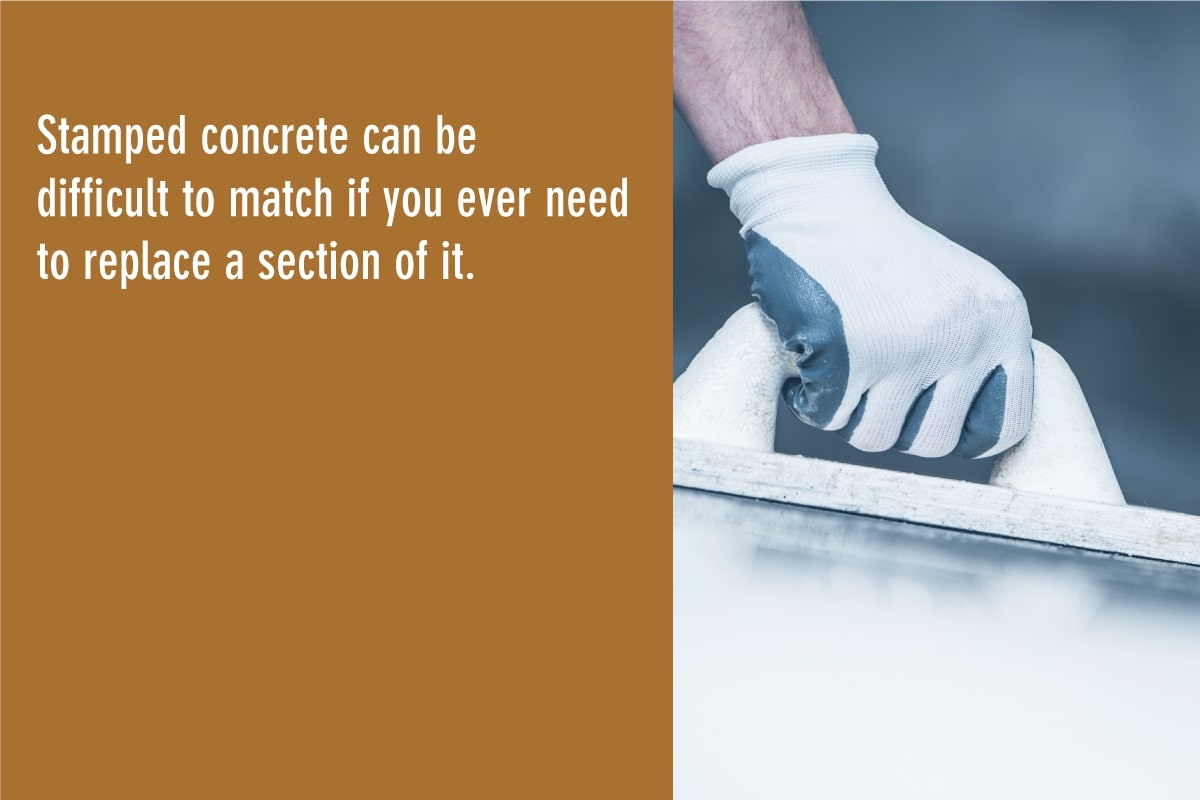
3 - Stamped concrete sometimes has uneven areas. While the texture in stamped concrete is beautiful, it can also cause problems.
Some stamps that show more aggressive patterns leave uneven areas on a hardscape. There’s a good chance you’ll have an area or two where a lawn chair might wobble or where a child could trip and fall. Water can also pool in these areas sometimes, which can cause premature aging of the materials.
When to Use Stamped Concrete
As we already mentioned, stamped concrete is best suited for those who are looking for a happy medium between pavers and regular concrete.
If you want to keep a decent budget but add some fun visual intrigue to your property, stamped concrete is the product for you.
Or, if you want a material you can easily incorporate into the existing design of your property, maybe you should consider stamped concrete.

Conclusion
We hope that you’ve found this article helpful and that you now know what kind of hardscaping material is best for you!
If you want more advice and tips on creating a gorgeous outdoor space, check out some of our other blogs:
- Lava Rock: What It Is And How To Use It In Your Landscaping
- Understanding The Pros and Cons of 8 Major Types Of Grills
- A Beginners Guide To Outdoor Playsets: 4 Tips For Any First-time Owner
- Polywood Is The Best Option For Outdoor Furniture - Here's Why
If you live near the Cumberland, MD area, and are looking for hardscape supplies, contact us at Ebyland!
We also offer everything you need for a beautiful backyard, such as:
- Landscape lighting
- A plant nursery
- Outdoor furniture
- Natural stone
- Grills and fire pits
- Water gardens
We want to make it as easy as possible to build your dream landscape!
Contact us or visit our store. We look forward to meeting you!
